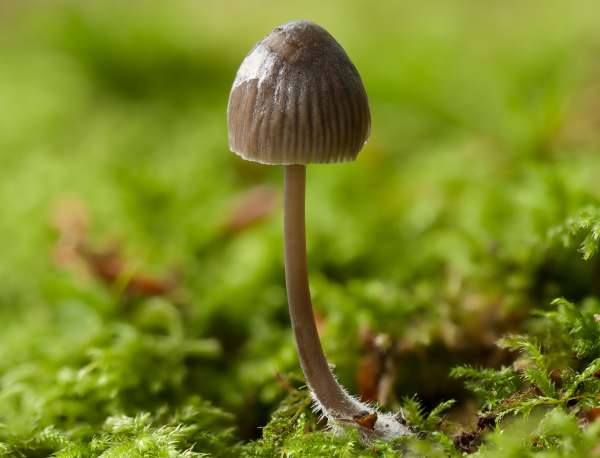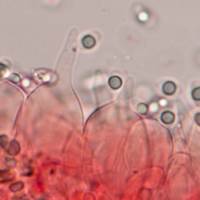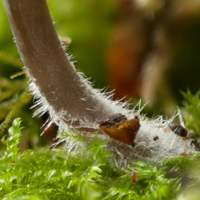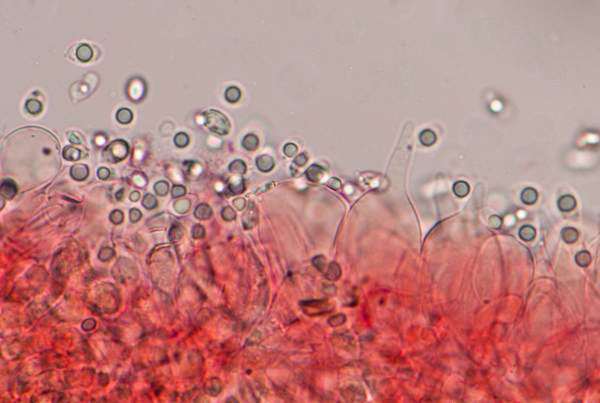Mycena abramsii (Murrill) Murrill
Phylum: Basidiomycota - Class: Agaricomycetes - Order: Agaricales - Family: Mycenaceae
Distribution - Taxonomic History - Etymology - Identification - Culinary Notes - Reference Sources

These rather drab bonnet mushrooms are not easy to identify from field characters alone, because there are so many nondescript lookalikes. MIcroscopy of cheilocystidia in particular helps to separate the various small, greyish-brown species in this confusing genus.
Distribution
In Britain and Ireland Mycena abramsii is widespread and fairly common. This nondescript little bonnet mushroom occurs throughout mainland Europe and many other parts of the world including North America, where they are sometimes referred to as Summer Bonnets.
Taxonomic history
American mycologist William Alphonso Murrill (1869 - 1957) described this bonnet mushroom in 1916, giving it the binomial scientific name Prunulus abramsii; however, in the same year he revised its designation to Mycena abramsii, by which name it is still generally known today.
Synonyms of Mycena abramsii include Prunulus abramsii Murrill, Mycena praecox Velen., and Mycena alnetorum J. Favre.
Etymology
The specific epithet abramsii honours the American botanist LeRoy Abrams (1874 - 1956).
Identification guide
 |
Cap1 to 3cm across; smooth, conical, becoming bell shaped; smooth with margin translucently striate; sepia brown to greyish brown at the centre, becoming a lighter shade of brown towards the rim. |
 |
GillsAdnexed to almost free; sinuose or slightly ventricose; white, buffish or pale grey, palest at the gill edge. |
 |
CheilocystidiaCheilocystidia (cystidia on the gill edges) 25-55 x 10-14μm, variably lageniform with slender necks (occasionally two or more such necks). Pleurocystidia (cystidia on the gill faces) are scarce but similar to the cheilocystodia. |
 |
Stem3 to 10cm long and 1 to 3mm in diameter; smooth, hollow and fragile; colour as cap but often paler towards apex; densely hairy at the base; no stem ring. Releases an unchanging colourless liquid from the cut or broken stem base. |
SporesEllipsoidal to sub-cylindrical, smooth, 7.5-13 x 4-6µm; inamyloid. Spore printWhite. |
|
Odour/taste |
Odour absent or slightly nitrous; taste not distinctive. |
Habitat & Ecological role |
Solitary or in small groups, usually attached to dead hardwood on the forest floor. |
Season |
June to October in Britain and Ireland. |
Similar species |
A similar woodland mushroom Mycena adonis, known as the Scarlet Bonnet, is also very small. An occasional find in both deciduous hardwood forests and in conifer plantations, the Scarlet Bonnet differs in having a reddish-orange or bright pink cap, and its stem is usually white (but red in var. adonis). Both species tend to occur as singletons or in small scattered groups. |
Culinary notes
These little fungi are far too small and insubstantial to be of culinary interest. It is unclear whether they are toxic or not.
Reference Sources
Fascinated by Fungi, 2nd Edition, Pat O'Reilly 2016, reprinted by Coch-y-bonddu Books in 2022.
Murrill, W.A. (1916). North American Flora. 9(5): 297-374.
Giovanni Robich, (2003). Mycena d'Europa; Associazione Micologica Bresadola ; Vicenza : Fondazione Centro Studi Micologici.
Dictionary of the Fungi; Paul M. Kirk, Paul F. Cannon, David W. Minter and J. A. Stalpers; CABI, 2008
Taxonomic history and synonym information on these pages is drawn from many sources but in particular from the British Mycological Society's GB Checklist of Fungi.
Acknowledgements
This page includes pictures kindly contributed by David Kelly.
Fascinated by Fungi. Back by popular demand, Pat O'Reilly's best-selling 450-page hardback book is available now. The latest second edition was republished with a sparkling new cover design in September 2022 by Coch-y-Bonddu Books. Full details and copies are available from the publisher's online bookshop...


